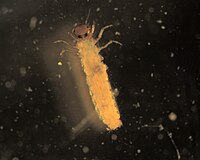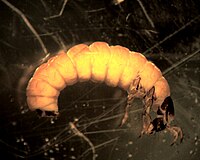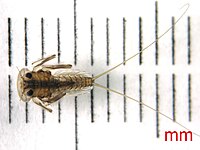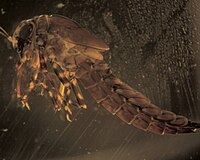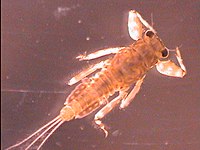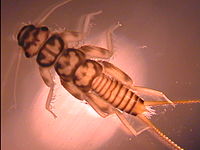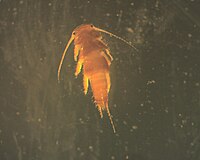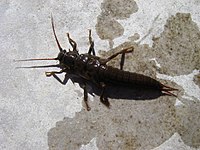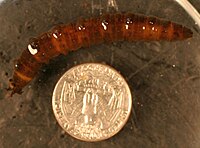Vermont EPSCoR's Streams Project; A Teacher Collaboration on WikiEducator
Openly shared content, practices, and developing resources from Vermont EPSCoR's Streams Project. Join this collaboration and make a difference!
 New Haven River |
|---|
|
| Basin: | Otter Creek |
| State or Province: | Vermont |
| Country: | USA |
| Latitude: | 44.096574 |
| Longitude: | -73.092226 |
| School: | Middlebury College |
Trichoptera
Hydropsychidae
- Order
- Trichoptera (caddisfly)
- Family
- Hydropsychidae
- Common name
- net spinning caddisfly
- Tied fly
- Emergent Sparkle Pupa, Vermont Hare's Ear
This family of net-spinning caddisflies is very abundant at several sites. They are important filtering collectors and are quite common at urban and agricultural sites where particles of organic material can be important food resources. Genus-level identification is possible for mature specimens and we will include the genera we found at your site if possible.
When using the key, some features that are challenging to see are the forked trochantin and the paired sclerites in the folds between segments. Other, more easily seen key features include filamentous gills on the abdominal segments and the sclerotization of the dorsal surfaces of all three thoracic segments. Keep in mind that with smaller or more immature specimens, genus-level ID may not be possible.
Commonly found genera include Cheumatopsyche, Ceratopsyche, and Hydropsyche. Less commonly, we have found Arctopsyche and Potamyia.
Images of the forked trochantin and the paired sclerites.
Limnephilidae
- Order
- Trichoptera
- Family
- Limnephilidae
- Tied fly
- Paul Young's Strawman Nymph, Grouse and Orange
This family of Trichoptera is characterized by having sclerotization on the dorsal surface of the first two thoracic segments. Also, it has a dorsal hump on the first abdominal segment, along with two lateral humps. Here, on a more mature specimen, one can see the
prosternal horn characteristic of it and another family Uenoidae. More information on the
Uenoidae.
Images of the dorsal hump, the two lateral humps, and theprosternal horn.
Glossosomatidae
- Order
- Trichoptera
- Family
- Glossosomatidae
- Common name
- saddlecase caddisfly
Larvae in this family build domed cases made of small rocks, and are often wider at segment 5. The pronotum is covered in dark, sclerotized plates, but there are either
no sclerites on the mesonotum, or the mesonotum is unsclerotized with the exception of a few patches. The anal proleg is broadly joined to segment 9; the anal claw has one or more accessory hooks. The
pronotal excision is small (approximately 1/3 anterolaterally) to accommodate the coxae.
Commonly encountered genera include Glossosoma and Agapetus.
Ephemeroptera
Heptageniidae
- Order
- Ephemeroptera
- Family
- Heptageniidae
- Common name
- flatheaded mayfly
- Tied fly
- Light Cahill, Wingless Pale Evening Dun
This family of mayflies can be characterized by their distinctly flattened heads and striking resemblance of the character 'Jack Skellington' from the movie 'The Nightmare Before Christmas.' This family can either have two or three cerci (tails).
Commonly encountered genera include:
Epeorus
Heptagenia
Maccaffertium
Rhithrogena
Isonychiidae
- Order
- Ephemeroptera
- Family
- Isonychiidae
This mayfly has unique long hairs on its forelegs as the main distinguishing characteristic (allowing anyone keying to move through quickly). Carefully observe the limbs because such hair can be matted down and therefore hidden in preserved wet specimens. The body of Isonychia is slim and "minnow-like" when observed dorsally. In specimens we collected, they were commonly brown and substantial in length and width as compared to the very common Baetidae. Some individuals are immature, but upon closer inspection one can see the setae on the forelegs.
Ephemerellidae
- Order
- Ephemeroptera
- Family
- Ephemerellidae
- Common name
- spiny crawler mayflies
- Tied fly
- Blue-Winged Olive
The mayfly
Ephemerellidae is distinguished by the absence of gills on the second abdominal segment; individuals either have gills on segments 3-7 or 4-7. Some may have operculate (plate-like) gills on the fourth segment, though in many the gills are of identical size. The most commonly found genera include
Drunella,
Ephemerella, and
Serratella.
More information on the genera Drunella, Ephemerella, and Serratella.
Ephemeridae
- Order
- Ephemeroptera
- Family
- Ephemeridae
- Genus
- Ephemera
- Common name
- The Coffin Fly
- Tied fly
- Dette Coffin Fly
Burrowing mayflies are common in soft sediments in Lake Champlain and also occur in muddy stream pools and in larger rivers. Nymphs have prominent forward-pointing tusks that curve upwards. The fore tibia have lobes or expanded areas that facilitate burrowing. Two genera are common in and around Vermont:
Ephemera and
Hexagenia;
Litobrancha also occurs.
Images of the tusks, and the fore tibia.
More information on Hexagenia.
Plecoptera
Perlidae
- Order
- Plecoptera
- Family
- Perlidae
- Common name
- The Golden Stonefly Creeper
- Tied fly
- Connecticut Curler
This stonefly is characterized by the three pairs of filamentous gills located on the sides of all three thoracic segments. It is distinguished from the family Pteronarcyidae by the absence of gills on the abdominal segments. Often, the thoracic terga are brightly patterned as pictured, though this is not always the case. Another important feature is that the paraglossae and glossae extend different lengths.
Images of filamentous gills and the family Pteronarcyidae.
Genera commonly encountered in this family include Acroneuria, Agnetina, and Paragnetina. Less commonly, we have found Perlesta.
Very rarely encountered genera include Neoperla and Hansonoperla. If you believe you have found either of these, please send a specimen our way!
Peltoperlidae
- Order
- Plecoptera
- Family
- Peltoperlidae
- Common name
- The Little Roach-like Stonefly
- Tied fly
- Yellow Humpy
Peltoperlidae have stout, roach-like bodies and can have conical gills at the base of legs. Ventral overlapping plates are found on their large thorax. They have a single gill on each side posterior to thoracic segment 3. Peltoperlidae is not covered in the family-level key (Bouchard 2006) used by the Streams Project.
Image of the single gill on each side posterior to thoracic segment 3.
Pteronarcys
- Order
- Plecoptera
- Family
- Pteronarcyidae
- Genus
- Pteronarcys
- Common name
- The Giant Stonefly
- Tied fly
- Kaufmann's Black Stone
Pteronarcyidae have branching gills from the bases of their legs as does
Perlidae. What distinguishes Pteronarcyidae from Perlidae is the presence of gills on the first two abdominal segments. There are only two genera in this family, but the other,
Pteronarcella, is only found in the west/southwest.
Click to see an example of Perlidae or the gills on the first two abdominal segments.
Diptera
Tipula
- Order
- Diptera
- Family
- Tipulidae
- Genus
- Tipula
This genus of Tipula is rather large as compared with other genera. Tipula larvae are generally dark brown and have creeping welts.
Chironomidae
- Order
- Diptera
- Family
- Chironomidae
- Common name
- Nonbiting midge
- Tied fly
- Griffith's Gnat
Midge larvae tend to be the most common macroinvertebrate at our sites. As with other Diptera, there are no true jointed legs. Chironomidae do have a pair of prolegs at each end and preserved individuals tend to curl into a 'C'. Identification past family requires slide-mounted heads. We have seen philopotamid caddisflies misidentified with the chironomids and we suspect that that happens when samples are being sorted from trays. Under a microscope, six prominent legs can be seen on members of the caddisfly family Philopotamidae.
More information on Philopotamidae.
Odonata

